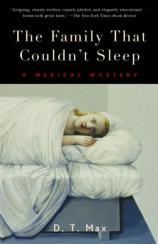The Family That Couldn't Sleep: A Medical Mystery
Review
The Family That Couldn't Sleep: A Medical Mystery
A prion disease is an illness caused by a protein that has become
deformed. A family in Italy suffers from an inherited prion disease
called fatal familial insomnia (FFI). The disease usually strikes
its victims when they reach their 50s. As one might guess from the
name, FFI victims lose the ability to sleep. When the disease first
strikes, they perspire, the pupils of their eyes shrink, and they
hold their head in a stiff, awkward manner. Eventually, they can no
longer walk. In a prolonged exhausted state until death, the
patients are completely aware of what is happening to them. The
Italian family was once the only known group with fatal familial
insomnia. Now, however, there are around 40 families around the
world known to have the disease.
The family has shunned publicity as much as possible. However, when
they learned that author D. T. Max suffers from a neuromuscular
disease that is also related to protein misinformation, family
members began to hope that publicity would speed work toward a
cure. Research uncovering information about FFI hopefully could
help other diseases in which proteins become deformed.
Prion diseases fascinate scientists. They seem to be the only ones
that attack in three forms: inherited, infectious and by random
chance. Researchers think prions are unique because, although they
are proteins, they can infect like viruses and bacteria.
Because it is so difficult to disinfect a prion, experts go to
great lengths to avoid contamination. Radiation, boiling and heat
won't kill prions. Scientists once opened a human brain afflicted
with prion disease after the victim had been dead 20 years, and
injected the brain tissue into lab animals. They all died of the
disease.
The author carries us from the Italian family to other prion
diseases, such as the sheep disease known as scrapie. In the 1820s,
the mysterious illness threatened England's robust sheep business.
Sheep afflicted with scrapie suffer such an itch that they scrape
themselves raw against walls and fences. Eventually the sheep die.
The many scientists who tried to discover the cause of scrapie
failed.
In New Guinea in the 1950s, doctors discovered locals suffering
another bizarre and puzzling illness, known as kuru. Victims,
mostly women and girls, shivered, became glassy-eyed and
cross-eyed, lost their balance, and died. Eventually scientists
stumbled upon a connection to scrapie. Yet no one could prove
exactly what the infectious agent was that caused these diseases
until a chemist named Stanley Prusiner decided it was a
"proteinaceaous infectious particle," which he dubbed a "prion."
Prusiner created quite a stir in the scientific community, but mad
cow was on the horizon --- and the experts' work had barely
begun.
THE FAMILY THAT COULDN'T SLEEP reads like a combination
anthropological and medical history, horror tale and sympathetic
unveiling of a cursed family. At heart it is a well-told medical
mystery. The colorful characters (including cannibals and quirky
scientists) are detailed in a manner that makes them live on the
page. The reader views the interlocking medical mysteries through
the empathetic lens of the author. I highly recommend this book as
a fascinating and terrifying read.
Reviewed by Terry Miller Shannon (terryms2001@yahoo.com) on January 21, 2011
The Family That Couldn't Sleep: A Medical Mystery
- Publication Date: September 11, 2007
- Genres: Medicine, Nonfiction
- Paperback: 336 pages
- Publisher: Random House Trade Paperbacks
- ISBN-10: 081297252X
- ISBN-13: 9780812972528




